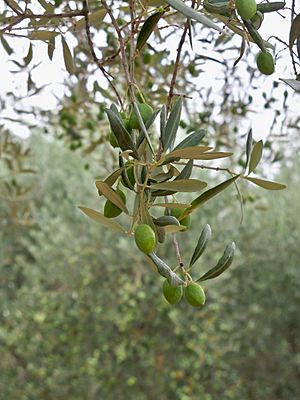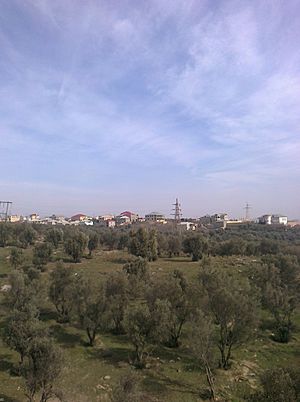Aglandau facts for kids
Quick facts for kids Aglandau |
|
|---|---|
 |
|
| Olive (Olea europaea) | |
| Color of the ripe fruit | Green |
| Also called | Beruguette, Blanquette, Plant d'Aix, Verdale de Carpentras |
| Origin | France |
| Notable regions | Provence |
| Hazards | Saissetia oleae, sooty mold, Spilocaea oleaginea |
| Use | Oil and table |
| Oil content | High |
| Fertility | Self-sterile |
| Growth form | Spreading |
| Leaf | Elliptic-lanceolate |
| Weight | Medium |
| Shape | Ovoid |
| Symmetry | Slightly asymmetrical |
The Aglandau is a special type, or cultivar, of olive that grows mainly in France. It's one of about a hundred different kinds of olives found there! You can find Aglandau olives mostly in a sunny region called Provence. But they also grow in faraway places like Azerbaijan and Ukraine.
People use Aglandau olives mostly to make delicious olive oil. But you can also eat them! When they are served as table olives, they are usually called Beruguette. The oil from Aglandau olives is very popular because it has a wonderful fruity taste.
Contents
Where Aglandau Olives Grow
The 'Aglandau' olive is very common in Provence, a beautiful region in southern France. You'll find lots of them in areas like Aix-en-Provence and Salon-de-Provence.
These olives have also traveled far from France. You can find them growing in Australia. They are also cultivated in countries like Azerbaijan and Ukraine.
Other Names for Aglandau
The 'Aglandau' olive has several different names, depending on where you are. These are called synonyms. Some common local names include Beruguette, Blanquette, Plant d'Aix, and Verdale de Carpentras.
In Azerbaijan and Ukraine, this olive is known as Nichitskaia 7. Remember, when you see 'Aglandau' olives served on a table to eat, they are usually called Beruguette.
What Aglandau Olives Look Like
The 'Aglandau' olive tree is not too big or too small. It grows in a spreading shape, with many branches and thick leaves. Its leaves are flat and shaped like a long oval, not too wide or too narrow.
The olives themselves are not very heavy. They are shaped like an egg, with a rounded top and a flat bottom. They are also a little bit uneven on each side. The hard pit inside the olive has a rough surface.
Harvesting Aglandau Olives
Farmers usually pick Aglandau olives in November and December. They try to harvest them before the cold frost arrives, which can harm the fruit. To make picking easier, the olive trees are often kept quite short. This is important because the olives are held very tightly to their branches! When the olives are fully ripe, they are green. The pit inside the olive sticks to the fruit's flesh, which is called "clingstone."
How Aglandau Olives Are Used
The 'Aglandau' is a "dual-use" olive. This means it's great for two main things: making oil and eating. It's mostly used to make olive oil, and it gives a good amount of oil, usually between 19% and 23% of its weight.
The taste of Aglandau olive oil is highly praised. People say it has a very fruity flavor. Some describe the smell of the oil as being like "almonds," "green apples," or even "artichokes." This olive is used to make several special olive oils that have official quality labels in France. These include "AOC Haute Provence," "AOC Pays d'Aix," and "AOC Vallée de Baux."
Growing Aglandau Olives
The 'Aglandau' olive tree is known for being a good producer, but not always every year. Sometimes it has a great harvest one year, and then a smaller one the next. This is called "biennial bearing." Farmers can help control this by carefully trimming the trees.
There's some debate about whether Aglandau trees can pollinate themselves. Most experts agree they are "self-sterile." This means they need pollen from other nearby olive varieties to produce fruit.
These trees can be affected by certain pests and diseases. For example, they can get black scale insects, sooty mold, and a fungus called olive leaf-spot. However, they are quite strong against other diseases like Verticillium dahliae and Pseudomonas syringae. Aglandau trees can handle dry weather well, but they don't like very cold temperatures.


